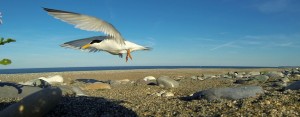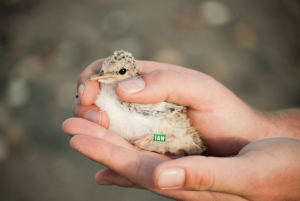- The remarkable bird life of the Wakatobi Islands, SE Sulawesi: hidden endemism and threatened populations - 10/07/2020
- The Bird Life of Wawonii and Muna Islands Part I: biodiversity recording in understudied corners of the Wallacea region - 30/06/2020
- Comparing the biodiversity and network ecology of restoredand natural mangrove forests in the Wallacea Region. - 09/12/2019

The last two years have seen successive record breeding seasons for Little Terns (Sternula albifrons) on the Irish east coast, with over 350 pairs breeding in 2013 and over 400 pairs in 2014. These record years are the result of 30 years of dedicated efforts to rescue Little Terns as an Irish breeding species, after population collapses in the 1980s and 1990s. As part of the BirdWatch Ireland team involved in these two exceptional years, we reflect on the conservation success story which has led to this remarkable tern-around in fortunes.
The Little Tern is Ireland’s second rarest breeding seabird. They breed in three main colonies on the east coast, Kilcoole (Wicklow), Baltray (Louth) and Wexford Harbour, and 10-15 smaller colonies on islands off the west coast. Little Terns breed in Europe, migrating to the west coast of Africa each winter. They arrive in Ireland from late April and leave with their fledged chicks in mid-August. The fledglings spend their first year in Africa, returning to breed in their second year. During the breeding season Little Terns nest on shingle beaches, with their nest being little more than a scrape in the shingle. Their eggs rely on their perfect camouflage for protection. However, this makes them acutely vulnerable to human disturbance, as eggs are easily trampled by people and dogs. The increased use of beaches as a recreational resource from the middle of the 20th century onwards led to severe population losses and the abandonment of many traditional colony sites such as the North Bull Island, Co. Dublin.
In response to this population decline the first Irish Little Tern protection scheme was initiated at Kilcoole in 1985 by BirdWatch Ireland and the National Parks and Wildlife Services. A section of the beach was fenced off from the public during the breeding season, with wardens on site to monitor breeding success and ward off potential predators. Coming from a low base of fewer than 20 breeding pairs in the mid-80s, numbers built slowly through the 1990s and Kilcoole was the only Irish Little Tern colony to maintain a breeding presence during this period. Good breeding seasons between 2003-2005 and 2008-2011 (50+ pairs, 100+ fledglings) paved the way for this year’s record success, with 120 pairs producing 219 fledglings.
The recovery of Little Terns was greatly aided by the initiation of a second wardening scheme at Baltray in 2007 by volunteers from the Louth Nature Trust, funded by the Heritage Council. BirdWatch Ireland joined the Baltray scheme as a partner in 2013. That year saw the Baltray colony more than doubling its previous success, with 102 pairs producing 193 fledglings. The 2014 season proved more difficult, with the colony suffering heavily from predation. However, the maintenance of a second wardened colony is hugely important, so that breeding success is no longer entirely dependent on a single site.

While wardened colonies such as those at Kilcoole and Baltray have succeeded in halting population decline in Little Terns in Britain and Ireland, their contraction in range has been much more severe [1]. Their vulnerability to disturbance has seen a shift towards fewer, larger colonies in the remaining areas where they are free from human disturbance, mostly in fenced off wardened areas or on offshore islands. This brings its own problems. Little Terns would naturally breed in smaller colonies, widely spread along shingle beaches. The more densely inhabited protected colonies are a beacon to predators, especially mammalian predators such as foxes, hedgehogs and mink, which can clean out a colony in a single night. Most wardened colonies have had to adopt elaborate fencing and 24-hour wardening to protect against heavy predation. While these fenced off areas are far from a natural environment, these wardening schemes have ensured the continued existence of the Little Tern as a breeding species, as well as having a positive knock on effect for breeding waders and other species which depend on the shingle beach habitat.
2014 was also a special year because we were lucky enough to be the first wardens to colour ring Little Terns in Ireland. Green darvic colour rings were used, with a unique three letter code in white writing, beginning with ‘I’. Between Kilcoole and Baltray 159 Little Tern chicks were colour ringed in Ireland this year. In addition to the Irish scheme Little Terns are being colour ringed with yellow colour rings engraved with black writing on the Isle of Man and at various other British sites. This will give us a much better understanding of the movements of Little Terns between colonies within the Irish Sea, their pre-migration staging posts and the routes they take through Europe on migration. It will also allow us to gain a greater insight into aspects of their biology such as pair fidelity, recruitment rate of fledglings into the breeding population, individual preference in nest location and adult longevity.

We have already started to reap the rewards as Kilcoole fledglings have been re-sighted at Hilbre Island in the Dee estuary, south Devon, Brittany and Lisbon. These first few sightings have already given us insight into how Little Terns move through Europe on migration. Hopefully these are the first of many sightings and we eagerly await summer 2016, when the first Little Terns colour ringed in Ireland should be returning to breed for the first time!
While 2013 and 2014 were unparalleled successes, Little Terns colonies are extremely vulnerable to predation and inclement weather. This was illustrated in 2012 when the east coast colonies experienced almost zero breeding success due to a series of storms. Therefore the continuation of current conservation measures are necessary for their survival. As well as its conservation value, the BirdWatch Ireland tern colonies have also proved an invaluable educational resource, providing a point of contact with the public. They have also provided inspiration, training and employment for many budding conservationists.
For more information about the Kilcoole project see the recent RTÉ news report on the project’s record year:
https://www.storehouse.co/stories/t0e0e-turnaround-for-little-terns
Or visit the project blog and see a recent documentary:
http://littleternconservation.blogspot.ie/
http://www.irelandswildlife.com/little-tern-conservation/
Darren O’Connell, Susan Doyle and Andrew Power
The 2013 Baltray and 2014 Kilcoole Little Tern Wardens
With a special thanks to Niall Keogh, Cole Macey, Jerry Wray, Tony Glass and Maurice Conaghy, our co-workers on many an early morning and late night, project manager Dr Stephan Newton and all the volunteers who make Baltray and Kilcoole tick.
Balmer, D., Gillings, S., Caffrey, B., Swann, B., Downie, I. and Fuller, R. (2013) Bird Atlas 2007-11: the breeding and wintering birds of Britain and Ireland. HarperCollins, UK.

